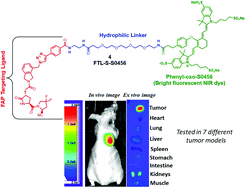Design and characterization of fibroblast activation protein targeted pan-cancer imaging agent for fluorescence-guided surgery of solid tumors†
Abstract
Tumor-targeted fluorescent dyes have been shown to significantly improve a surgeon's ability to locate and resect occult malignant lesions, thereby enhancing a patient's chances of long term survival. Although several tumor-targeted fluorescent dyes have been developed for imaging specific subsets of human cancers, no tumor-targeted dye has been designed that can image all cancer types. Based on observations that fibroblast activation protein (FAP) is upregulated on cancer-associated fibroblasts (CAFs) that infiltrate essentially all solid tumors, we have undertaken to develop a FAP-targeted fluorescent dye that can image CAFs without accumulating in healthy cells or fibroblasts. We report here that FTL-S-S0456, a novel FAP-targeted near infrared dye that binds FAP with high affinity (∼12 nM) and specificity (>5000-fold over PREP and DPP-IV), concentrates in all seven solid tumor types examined, yielding fluorescence images with high tumor to background ratios that persist for several days. We conclude that FTL-S-S0456 constitutes an excellent ligand-targeted near infrared dye that enables intra-operative imaging of most if not all solid tumors.



 Please wait while we load your content...
Please wait while we load your content...